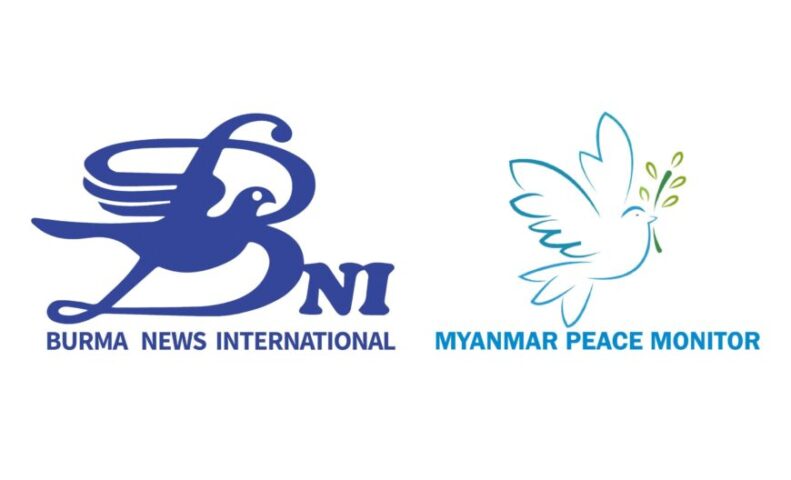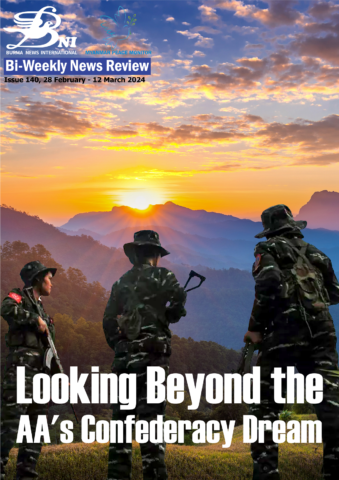
Introduction
“Given the current battlefield and political situations, I believe that now is the best opportunity for all the people of Myanmar to fight for the liberation from the military dictatorship.”
This is the opinion of Major General Twan Mrat Naing, Commander-in-Chief of the United League of Arakan/Arakan Army (ULA/AA), about the current military junta, and the political situation in Myanmar. On 15 April 2021, when the National Unity Government (NUG) was formed, the AA chief also clarified to the public about the non-participation of the ULA/AA, saying, “They cordially invited us to join them. It was solely our position not to join; there is no need to blame them.”
The military momentum of ‘Operation 1027,’ initiated by the Three Brotherhood Alliance (3BHA),of which the ULA/AA is a member, has been observed with suspicion. Questions arise as to whether it might pause after achieving some territorial gains, be halted by the ‘Haigen Agreement’ brokered by China, or signify a shift in the country’s trajectory towards confederation or a federal democratic union.
This week’s Burma News International (BNI)-Myanmar Peace Monitor’s Bi-Weekly News Review focuses on the military momentum and political aspirations of the United League of Arakan/Arakan Army (ULA/AA), which has taken control of up to eleven towns in Arakan State and Chin States as part of Operation 1027, drawing on data, events and statements from AA leaders.
The emergence of the Arakan Army
When the Arakan Army was formed on 10 April 2009, its objectives were to bring protection, peace, justice, liberty and development to the people of Arakan. Achieving self-determination for the multi-ethnic people of Arakan, preserving the ethnic characteristics and cultural heritage, and promoting the dignity and interests of the Arakanese are the aims of the ULA/AA. 1
Although the ULA/AA participated as a member of the Nationwide Ceasefire Coordination Team (NCCT) during the ceasefire process under the U Thein Sein administration, it was left out when the Nationwide Ceasefire Agreement (NCA) was signed on 15 October 2015 by the U Thein Sein administration.
With over 30,000 troops, the ULA/AA initially fought alongside allied Ethnic Revolutionary Organizations (EROs) and gained experience on the battlefield. However, tensions escalated after the AA launched coordinated attacks on four border guard outposts of the military regime in Buthidaung, Maungdaw, Rathedaung and Kyauktaw Townships in Arakan State on 4 January 2019. Intense clashes continued until shortly before the 2020 general elections.
However, after talks between the ULA/AA and the military regime on 30 December 2020, the two sides abruptly ceased hostilities. And on 11 March 2021 after the military coup, the military council removed the ULA/AA from its list of terrorist groups. As nationwide opposition emerged against the junta’s putsch, the ULA/AA itself moved to take control of the administrative and judicial sectors within Arakan State.
Although there has been much suspicion and questions about the ULA/AA’s lack of involvement in the Spring Revolution’s circle pushing to overthrow all forms of authoritarian systems, including the military dictatorship, and work towards building a federal democratic union, it can be said that the ULA/AA made steady progress while maintaining information security and biding its time and grand strategy to achieve its goal.
When “Operation 1027″ was launched in northern Shan State, the ULA/AA took a leading role alongside the Myanmar National Democratic Alliance Army (MNDAA) and the Ta’ang National Liberation Army (TNLA). After the Haigen Agreement reached through China’s mediation, the ULA/AA intensified its offensives on outposts and towns in Paletwa Township of Chin State and throughout Arakan State.
Outpost/town captures and the AA’s military momentum
According to BNI-Myanmar Peace Monitor records, from January 2019 to 12 March 2024, there were a total of 547 armed clash events between military junta troops and the United League of Arakan/Arakan Army (ULA/AA). The number of armed clash events after the military coup is found to be slightly higher than the number that occurred in 2019 and 2020 before the coup.
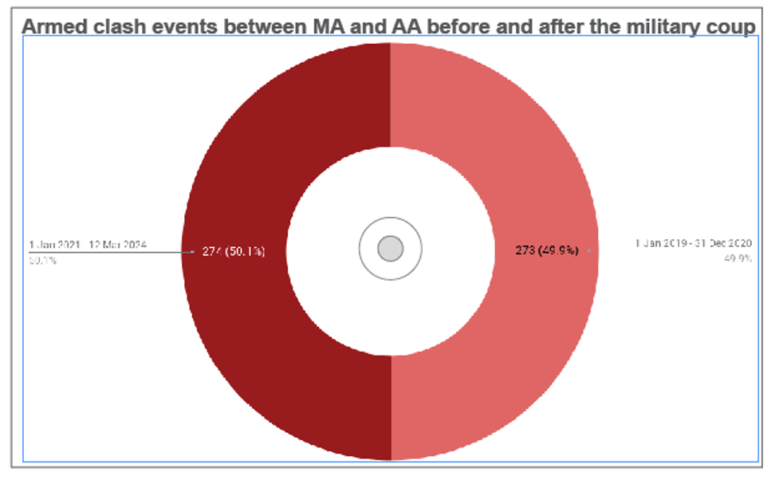
Of these, there were up to 179 armed clash events between the military council troops and the ULA/AA after “Operation 1027” which started on 27 October 2023. Moreover, since the China-mediated Haigen Agreement, starting from January 2024, the Arakan Army’s offensive against the coup regime has gained momentum.
Starting from 2024, the ULA/AA has seized control of Paletwa on 14 January and Sami on 16 January in Chin State, Pauktaw in Arakan State on 19 January, Minbya, Kyauktaw on 6 February, Mrauk-U on 8 February , Myebon on 15 February, Ponnagyun on 4 March, Ramree on 11 March, and Rathedaung on 17 March.
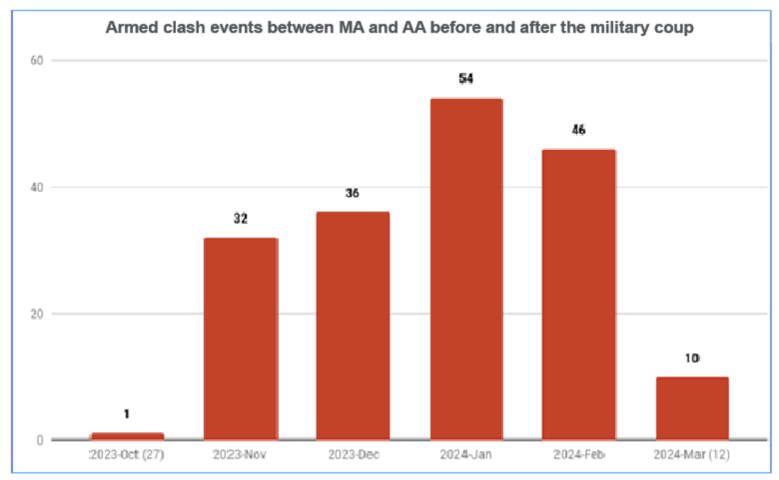
Looking Beyond the AA’s Confederacy Dream
“The right to self-determination and sovereignty is at the heart of our national movements. We will see if a federal democratic union of Myanmar will have the political space for the kind of confederation that our Arakanese people aspire for,” said ULA/AA leader Major General Twan Mrat Naing in an interview with Bertil Lintner on 18 January 2022. 2
He also stated that while they prefer to remain with their ethnic brothers and sisters, if they cannot achieve a suitable political status within the future federal democratic union, they will have to strive for acceptance within the international community.
In just six months since the start of Operation 1027, the resistance forces, including EROs, have managed to take control of up to 51 towns across the country. After the coup regime regained control of Kawlin town, 50 towns remain under the control of the resistance forces. Among these, the ULA/AA has taken control of 11 towns in Chin and Arakan States under its control.
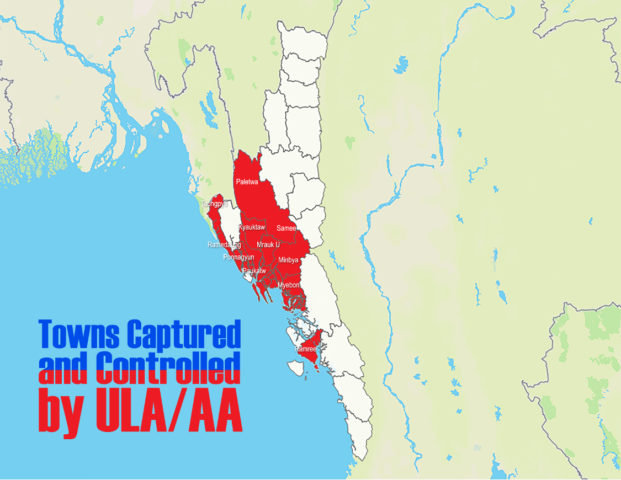
In an interview with the BBC in February 2024, Major General Twan Mrat Naing said: “We want to build the future together in unity. But, if we do not get what we want and deserve, there could be other considerations. Rather than just talking about these things, we are thinking of building up our fundamental strength first. And then, at the appropriate time, we will discuss carefully and practically and act according to the situation and circumstances.” 3
Review
The military momentum of the United League of Arakan/Arakan Army (ULA/AA) remains strong. As can be observed, there has been military cooperation with the Ethnic Revolutionary Organizations (EROs), including the People’s Defense Forces/Local Defense Forces (PDFs/LDFs), which are engaged in armed revolution to overthrow the military dictatorship, as well as some political meetings with the National Unity Government (NUG). In addition, there were situations in which the ULA/AA, alongside allies from the Three Brotherhood Alliance, met with representatives of the military council, due to China’s mediation efforts.
Since Major General Twan Mrat Naing has stated that they will continue their military operations to fully control the entire Arakan region, the follow-up military momentum of “Operation 1027” beyond the Haigen Agreement seems to be aimed at liberating Arakan. The ideology of the United League of Arakan/Arakan Army (ULA/AA), which originated from the ‘Way of Rakhita’ or Arakan national objectives, appears to be shifting towards the liberation of all ethnic groups, equal rights for all without discrimination based on race or age, and the unity of all ethnic communities.
While the Spring Revolution forces aim to overthrow the military dictatorship and build a federal democratic union, the “confederacy status” proposed by the ULA/AA could also become a consideration. As Major General Twan Mrat Naing has said:
“Our thinking is that we do not accept the concept that all problems in a country must fit into a single system or principle.” 4
1 Deciphering Myanmar’s Peace Process – A Reference Guide (2015), Page 153
2 Rebel yell: Arakan Army leader speaks to Asia Times
3 “It’s true that we have ‘Arakan Dream’ but we need liberation for all ethnic groups, equality and peace.”, AA Chief
4 An interview with AA military chief (Second installment)
